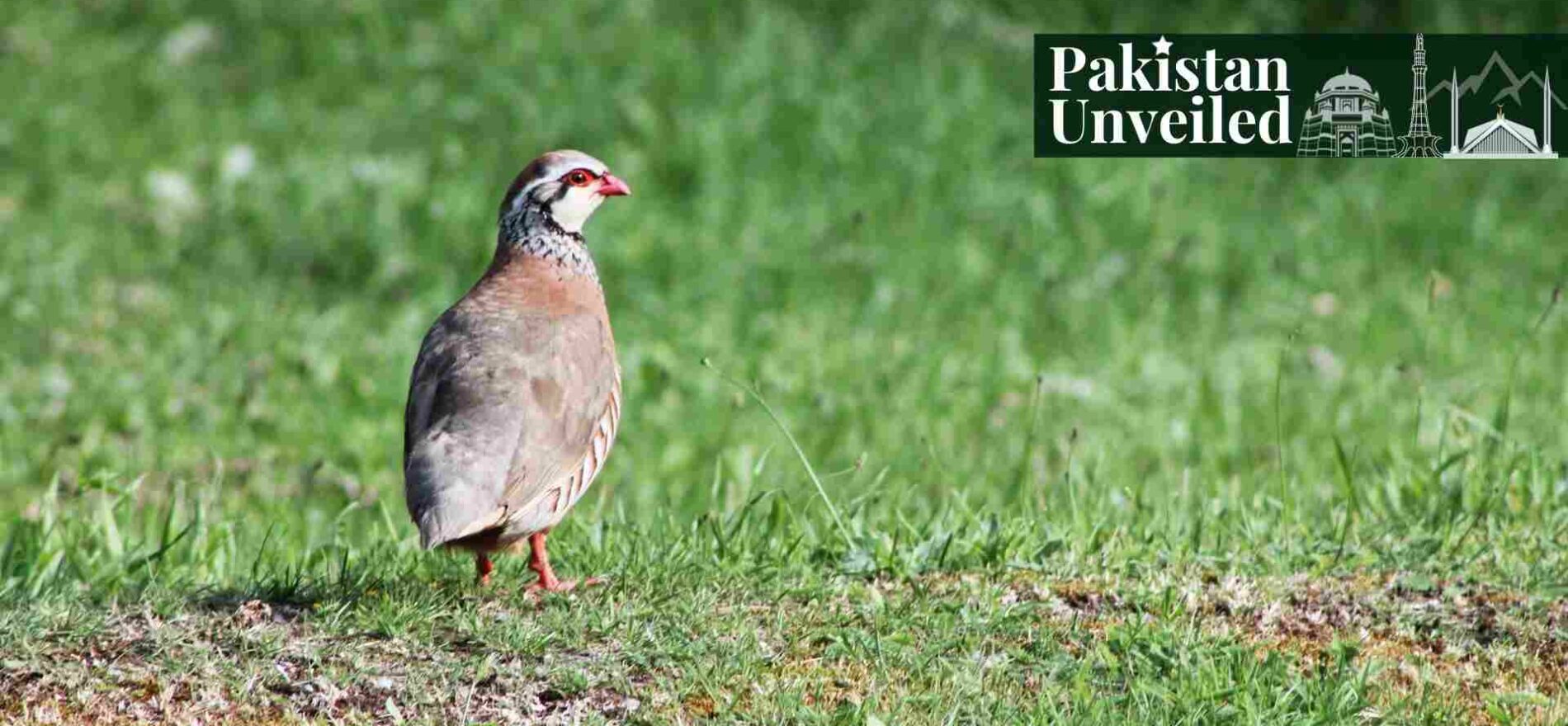Paradigm Shift is an official staff account.
Introduction
Pakistan’s diverse geography, from the Himalayan peaks to the Arabian Sea’s coastal plains, harbors a rich avian population. Forests, wetlands, grasslands, deserts, and high-altitude areas provide varied habitats. Astola Island and Attabad Lake add to the country’s allure, attracting birdwatchers and conservationists. This diverse birdlife captivates both local and international enthusiasts.
The chukar partridge possesses several unique characteristics that make it a fascinating bird. Native to rocky regions of Pakistan, southern Europe, the Middle East, and parts of India, and China, the chukar partridge has also been introduced to various other regions worldwide. Its appearance is distinct, with a stocky build, plump body, and short wings. Males and females share similar features, but males are slightly larger and more brightly coloured.

Chukar partridges are primarily ground-dwelling, but they can fly with rapid, direct flights. They form small groups called coveys and spend much of their time foraging on the ground. During the breeding season, they form monogamous pairs, and females construct shallow scrape nests on the ground. Overall, the chukar partridge’s adaptability, attractive appearance, and distinct vocalizations contribute to its unique characteristics and make it an intriguing bird species.
Why is Chukar Partridge the National Bird of Pakistan?
The chukar partridge was declared the national bird in 1985 due to its historical and cultural significance in Pakistan. This bird has been a part of the region’s ecosystem for centuries and has become intertwined with the country’s heritage. Some of the specific regions where the chukar partridge is commonly found in Pakistan include the Gilgit-Baltistan and Khyber Pakhtunkhwa provinces, as well as the Balochistan and Punjab provinces. The bird can be found at elevations ranging from sea level up to around 4000 meters in the mountains.
As the national bird, the chukar partridge has been depicted in artwork, poetry, and literature, representing the rich natural heritage of Pakistan. The choice to declare the chukar partridge as the national bird also reflects the country’s commitment to the conservation and preservation of its natural resources.
By selecting a native bird as a national symbol, Pakistan highlights the importance of protecting its unique biodiversity and raising awareness about the need for environmental stewardship.
Chukar partridges are popular among hunters in Pakistan as game birds. They are known for their challenging and fast-paced flight, making them a sought-after target for hunting enthusiasts. The bird’s meat is also highly regarded for its taste and is often used in various culinary preparations.
Chukar Partridge in Pakistan
In Pakistan, the chukar partridge is commonly known as “Chakor” or “Cheer”. The name “Chakor” is derived from the Urdu language; it is believed to be derived from the Persian word “Shakar”, which means “sugar”. This name may be a reference to the bird’s sweet-sounding call, which is a series of high-pitched whistles.
Physical Appearance
Chukar partridges measure approximately 32-35 centimetres (12.6-13.8 inches) in length while weighing between 500-700 grams. They have plump, round bodies with relatively short tails. Their body shape is similar to that of a typical partridge. Chukars have a striking and distinct plumage pattern.

The general colouration of their upper parts is greyish-brown or sandy-brown, which provides excellent camouflage in their natural habitat. The feathers on their back and wings often have darker stripes or spots. The breast is a vibrant and contrasting orange or rusty-red colour. They also have a white face with a black band running across their eyes, which gives them a distinctive facial pattern. The belly and lower flanks are light grey or white.
The chukar partridge has a distinctive red bill that is short and strong, with a slightly curved tip. Its eyes are a dark brown colour, set in a white eye ring. They also have short, rounded wings. When in flight, their wings produce a distinctive whirring sound. Their legs are relatively short and sturdy, adapted for walking and running, and their feet are strong and have sharp claws, enabling them to easily navigate rocky terrains.
Males and females of chukar partridges display slight differences in appearance. Males generally have a bolder and more defined facial pattern with a larger black eye band. They may also have slightly brighter and richer plumage colours compared to females.
Breeding Behavior and Nesting Habits
These birds are diurnal, being most active during the day in the early morning and late afternoon. During the breeding season, which typically occurs in spring and summer, male chukar partridges engage in elaborate courtship displays to attract females. These displays may include fluffing their plumage, bobbing their heads, and making soft clucking calls. Males may also engage in territorial behaviour, defending their chosen nesting sites from other males.

Nesting occurs on the ground, often in concealed locations among rocks, shrubs, or tall grasses. The female constructs a shallow nest lined with grass and leaves. She lays a clutch of 8 to 20 eggs, which are incubated for approximately three weeks. The male may assist in incubation duties as well. Once the chicks hatch, they are precocial, meaning they are relatively independent and able to leave the nest soon after hatching.
Vocalizations and Communication Behaviours
Chukar partridges are highly gregarious birds and prefer to live in close-knit groups. They communicate with a variety of vocalizations, including distinctive calls that serve to maintain contact within the covey and warn of potential threats. These calls can be heard echoing through the rocky hillsides.
When faced with danger, chukars rely on their agility and ability to blend into their surroundings. They will quickly seek cover among rocks or in dense vegetation, using their cryptic plumage to remain hidden from predators. If necessary, they can take flight swiftly to escape danger.
Chukar Partridge’s Diet
Chukar partridges have a diverse and adaptable diet, which allows them to thrive in a variety of habitats. These birds are omnivores, feeding on a range of plant materials, insects, and other small invertebrates. During the summer months, the chukar’s diet primarily consists of plant materials such as grasses, leaves, buds, and seeds. They have been known to feed on a variety of plant species, including sagebrush, cheatgrass, and Russian thistle.

Chukars may also consume fruits such as wild berries and seeds from various shrubs and trees. Insects and other small invertebrates become a more important part of the chukar’s diet during the fall and winter months when plant materials are less abundant. These birds are known to also feed on grasshoppers, crickets, beetles, ants, spiders, and other small invertebrates.
The chukar’s foraging behaviour is highly opportunistic. They have been observed pecking at the ground, digging into the soil, and turning over rocks and other objects in search of food. They may also climb shrubs and trees to access fruits and other food sources. These birds require regular access to water for drinking and bathing. They have been known to travel several miles in search of water, and they may also obtain water from dew, moisture on plants, and other sources.
Chukar partridges are well adapted to arid and semi-arid habitats, where water and food can be scarce. Their diverse and adaptable diet allows them to survive in these challenging environments. They are also able to adjust their foraging behaviour in response to changing environmental conditions, such as fluctuations in temperature and rainfall.
Conclusion
The chukar partridge, or chakor, is a beloved and iconic bird in Pakistan, where it is celebrated as the national bird. Its distinctive calls, ground-dwelling habits, and striking appearance make it a fascinating and treasured species. The bird’s adaptability and resilience have allowed it to thrive in a variety of habitats, from rocky deserts to mountain slopes.
Despite facing some threats, such as hunting and habitat loss, the chukar partridge remains a symbol of resilience and strength for the people of Pakistan. Its status as the national bird highlights the importance of preserving and protecting this unique and remarkable species for future generations.
If you want to submit your articles, research papers, and book reviews, please check the Submissions page.
The views and opinions expressed in this article/paper are the author’s own and do not necessarily reflect the editorial position of Paradigm Shift.




















